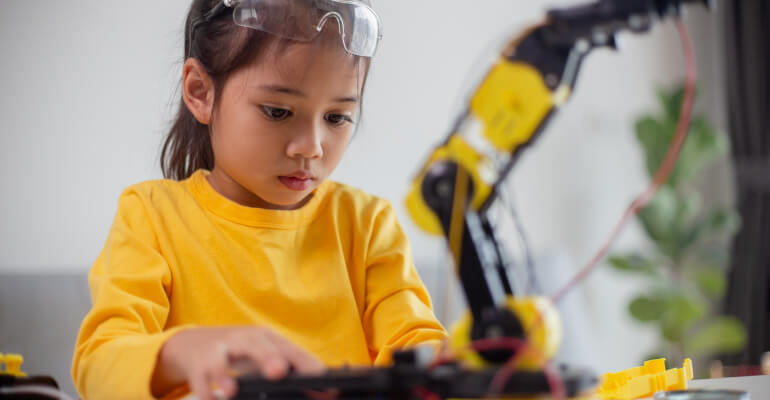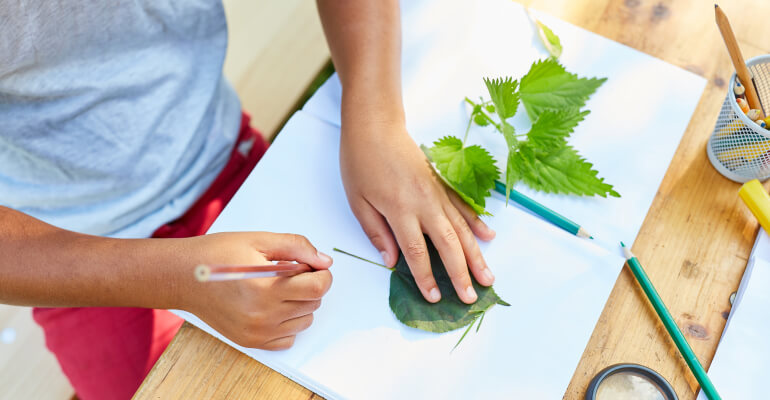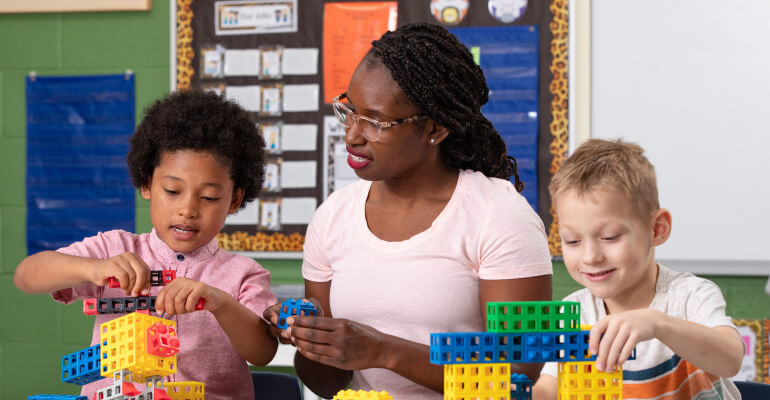Fall into STEM with these exciting STEM activities for kindergarten to 5th-grade classrooms.

If you’re looking for fun, hands-on STEM activities for fall, Kid Spark Education has got you covered! Whether or not you use Kid Spark’s comprehensive elementary STEM curriculum and lab kits, you can explore exciting new concepts in science, technology, engineering, and mathematics with these STEM activities designed for fall.
These elementary STEM activities will get your students’ wheels turning as they explore robotics and engineering with a Robotic Corn Maze, discover patterns and symmetry in nature, or learn about gravity with Fall’s abundance of apples—something Sir Isaac Newton himself would appreciate!
We’ll provide a thorough overview of each STEM activity, along with helpful tips for teachers and educators to incorporate them into your elementary classroom.
If you’d like to explore our structured elementary STEM curriculum and lesson plans, contact us today. We’d love to learn more about the STEM goals you have for your class!
Where STEM Activities Fit Within Your STEM Curriculum
STEM activities are a great way to further explore STEM concepts you’ve introduced to the class through instruction, introduce new concepts in a fun and engaging way, or show students how STEM concepts can work together to solve problems.
- Solidify STEM knowledge through STEM classroom activities
Use engaging STEM activities as a way for students to practice what they’ve learned through your existing STEM curriculum and instruction. When you’ve completed instruction for a STEM concept, consider including a hands-on STEM activity in addition to any written assessment. These interactive activities help students understand the real-world applications of the concepts they’re learning and put their newfound knowledge to use!
- Introducing a new STEM concept with STEM activities
You can also try introducing a new STEM series or instructional unit with a hands-on STEM activity. This is a fun way to get students involved and help inspire their natural curiosity.
If you’re starting a new unit or subject of science, you might start out with a physical demonstration and STEM activity (like the How Does Daylight Savings Time Work activity below).
- Highlight crosscutting subjects in STEM through applications
STEM activities often incorporate multiple STEM concepts. This creates a wonderful opportunity to show students the relationships between STEM concepts and how they work together to solve problems and help us understand the world around us.
7 Fall STEM Activities for Kindergarten through 5th Grade
We love STEM activities that are discovery-based and help students explore their own curiosities. These are some of our favorite STEM activity ideas for elementary students.
Seven STEM activities for fall to bring into your elementary classroom:
1. How Does Daylight Savings Time Work?
Start this STEM activity by showing the class a demonstration of how the sun’s daylight is affected by the earth’s axis and explain how daylight savings time allows us to shift our available daylight to match our schedules. With a flashlight and a globe, show your students how much daylight our hemisphere receives in spring versus fall.
Students can then draw models (with guidance) of how daylight savings time works and label a clock before and after the daylight savings shift.
You can also incorporate applied mathematics by creating worksheets where students can solve for the time difference or calculate what time it is based on location and season.
2. Exploring Gravity with Fall Apples
Understanding force and motion is a core STEM concept that can be introduced very early on. In our all-in-one STEM curriculum and labs, we introduce gravity to students in our Foundational Fluencies STEM Lab Kit Unit: Making Things Move for students Pre-K through 1st Grade.
This fall STEM activity on gravity pairs well with the Exploring Gravity lesson plan as an additional exercise to reinforce the key concepts discussed in the lesson. However, it does not require any curriculum or components from a Kid Spark Lab Kit.
To explore gravity with apples, you’ll need:
-
- Apples
- Yardstick(s)
- Tape
- Paper and Pencils
Start by introducing (or reiterating) the concept of gravity—as a force that pulls objects towards the earth and causes an apple to fall down rather than up or sideways.
In groups, students can hold an apple at different heights and drop it, recording their observations and observing how the apple falls straight down each time.
For older elementary students, you can have them design their own apple gravity experiments, recording their predictions and observations in the process.

3. Why Do Leaves Change Colors?
In this STEM activity for fall, students learn about the different pigments of leaves and how the changes in autumn weather affect them. This simple STEM activity can be adapted for multiple grade levels.
For young elementary students in Kindergarten or 1st grade, you can use a diagram to show the different parts of a leaf and how chlorophyll masks the other pigments due to changes in the weather, study the varied colors in real leaves, and draw and color their own colorful autumn leaves.
For 2nd through 5th grade, you can practice the anthocyanin and carotenoid pigments and how they make leaves red, yellow, and orange. As a class, you can sort fall leaves, create a color chart of all the different pigments, and review the lifecycle of leaves, from chlorophyll-filled green leaves to the crunchy fall leaves on the ground.
4. Patterns and Symmetry in Nature
Invite your students to gather various natural materials such as leaves, flowers, seeds, rocks, etc., as you gather images of patterns and symmetry found in nature like butterfly wings, flower petals, or spiderwebs.
As a class, observe and discuss the various patterns and symmetry you find in nature and why symmetry is important in nature. Have your students sketch the natural objects, identifying patterns or symmetry, or provide drawing worksheets with half an image of an object found in nature and have your students draw the symmetrical companion.
If the fall calendar aligns just right, you might even add a spooky twist to this fall STEM activity by focusing on the symmetry of spiderwebs!
(This fall STEM activity goes great with the Patterns & Pyramids lesson in the Foundational Fluencies STEM Lab.)
5. Leaf Boats
Did you ever race leaf “boats” or twig “boats” down a stream as a kid? With fall’s abundance of foliage, we’ve made a fun fall STEM activity to share with your elementary students.
To practice the engineering process of planning, designing, testing, and modifying a prototype, students will design and construct a boat out of tape and natural materials.
Rather than race downstream, they’ll measure how much weight each leaf can hold (maple, oak, sycamore, etc.). Students add pennies as weights and record their results before redesigning their boats to try to improve the amount of weight they can hold.
Don’t forget to discuss this hands-on STEM activity with your students after they’ve tested and retested their designs. Discuss the design principles that allowed boats to hold more weight, or brainstorm other materials they might use to build boats.
6. Measuring Volume of River Dams
In the fall, many river dams are affected by fluctuating water levels, heavy rainfall, fish migration, or even shortened days (as the needs of hydroelectric power may increase the demand for electricity). That’s why it’s essential to know the volume capacity of a river dam.
This applied mathematics STEM activity is perfect for fall, as you can tie-in timely real world applications of measuring a river dam’s volume.
In the Kid Spark STEM Labs for 2nd–5th grade, we introduce how to measure volume by determining the length, width, and height of an object. Whether your students have completed this lesson in our curriculum or have learned how to measure volume through your own curriculum, this STEM activity is a fun way to explore applied mathematics.
Start by introducing how dams are built to hold back river water and create reservoirs, then have students measure the length, width, and height of a mock dam made of cardboard boxes.
Students will learn how to calculate the volume of a river dam by using measurement and geometry and understand how volume relates to the amount of water a dam can hold.
7. Robotic Corn Maze
The STEM Pathways Lab for Grades 2–5 by Kid Spark introduces students to basic coding and robotics in elementary school. In each STEM lab are reusable robotic components for multiple lesson plans and activities. This fall STEM activity uses the same robotic components, and can be a great additional activity after the Ball Maze lesson plan.
Rather than creating a new activity from scratch, use the same robotic Spark:bit components for students to create their own maze as if it were a seasonal corn maze. While the components and process remain the same, students can have fun with the fall-themed tie-in.

Tips & Tricks for STEM Activities in the Elementary Classroom
Once you’ve found a fun fall STEM activity for your class, here are a few pointers to make the STEM learning experience a success.
Ask Questions
For elementary classrooms, asking and answering a question about the real world is a great launching point for STEM learning. That’s why you’ll find activities like Why Do Leaves Change Colors, or What Is Daylight Savings Time in our favorite fall STEM activities.
Answering a question or solving a problem using STEM helps young students understand the various applications of STEM concepts and retain the knowledge from each activity, being able to recall STEM concepts more easily.
In addition to asking questions as a class to solve a problem, remember to ask your students many different questions during and after each STEM activity. This not only helps them practice communicating the STEM concepts they’re learning, but it also helps develop their critical thinking and logic skills.
Incorporate the Senses
Young learners at the elementary level benefit from multimodal learning experiences. This means teaching while engaging various senses: sight, hearing, touch, etc.
As you’re introducing these STEM activities, or creating your own, be sure to incorporate a few different representations of the activity such as your verbal instruction, visual chart in the front of the classroom to reference during the activity, the hands-on activity, and an opportunity to discuss and share their own observations verbally. This will help students of all learning types and improve retention overall.
[Learn more about how to support visual learners in elementary school STEM]
Support a Positive STEM Identity
STEM identity is how a person sees themselves in relation to the fields of STEM, and it’s important to support a positive STEM identity while students are young so that they build confidence in themselves and their capabilities in connection to STEM.
To support a positive STEM identity in elementary students, celebrate their successes, keep students engaged at their learning edge, and embrace experimentation rather than focusing on mistakes or failure. For a more in-depth look at STEM identity at the elementary level, we’ve written an entire blog post here.

Bring Kid Spark to Your Classroom
Kid Spark Education is a nonprofit organization dedicated to bringing access to STEM education to every student. We’ve developed comprehensive STEM curricula and lab kits for students from Pre-K through 8th Grade with tools to empower educators with everything they need to be powerful STEM mentors.
If you’re interested in learning more about how to bring our all-in-one STEM labs and curricula to your classroom, contact us today.
.png?width=1270&height=453&name=Copy%20of%20Kid%20Spark%20Logo%20(Horizontal%20-%20Full%20Color).png)